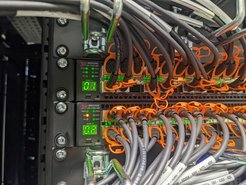Central IT Unit
Heads:
Moataz Elmasry (as of 12/2021)
Joachim Schmitz (06/2020–12/2020)
Sebastian Lau (until 06/2020)
The Central IT Unit is a critical component of the Institute, responsible for ensuring that all IT operations run smoothly. It consists of two key units: the Infrastructure Unit and the Servicedesk Unit. The Infrastructure Unit is responsible for building and maintaining crucial IT components—such as the internet infrastructure, WiFi, networks, and storage—within the data center. This plays a pivotal role in ensuring that the entire IT system runs efficiently and effectively, which is essential for the Institute to meet its goals and objectives. The Servicedesk Unit provides much-needed support to the Institute’s users in their daily work, acting as a single point of contact for any IT-related issues users may have, including troubleshooting, technical support, and service requests. By providing this support, the Servicedesk enables the Institute's users to focus on their core responsibilities, thus increasing productivity and enhancing overall performance. Together, the Infrastructure and Servicedesk Units form the vital backbone of the Institute’s IT operations, ensuring that the organization remains at the cutting edge of technology and can meet the challenges of a rapidly evolving digital landscape.

The years 2020–2022 were truly the years of the user. When lockdown began in early 2020, IT was not in a position to support users working from home. During that time, we procured and configured a significant number of laptops to support mobile work, as well as web cameras and other equipment to support users in the unusual circumstances. Furthermore, we overhauled our whole VPN infrastructure by purchasing new software and licenses, as the VPN infrastructure was designed to sustain all the Institute’s users simultaneously.
During the COVID-19 pandemic, we also upgraded the Servicedesk significantly, starting with the move to a new Servicedesk software (Atlassian Servicedesk) and working on documentation, processing automation, and building different request types so that users could get assistance as fast as possible. In total, during the COVID-19 years, we resolved over 6,000 support tickets and wrote more than 100 internal and external help pages.
Furthermore, we installed several new hardware components, for example a new Dell Isilon storage cluster with about 800 Terabyte storage capacity to meet users’ increasing need for more storage, as well as a state of the art WiFi controller and a new firewall. We also renovated our internet gateways together with our colleagues from the Gemeinsames Netzwerkzentrum (GNZ). The installation of these new components led to a better network infrastructure within the Institute and with our internet connectivity in general.
In the Infrastructure Unit, one event clearly stands out: the decommissioning of the outdated Citrix environment and the building of a comparable setup in the Microsoft Azure Cloud, called Azure Virtual Desktop. The new Azure solution proved to be around 70% cheaper than the previous solution.
Moreover, we introduced several new software programs for the Central IT Unit that help us manage the whole IT landscape. For example, we introduced Baramundi and JAMF, which are mobile device management software programs that simplify the orchestrating and managing of over 600 personal devices at the Institute, while also increasing our ability to push important security updates and enabling us to offer more software programs that aid research. We also introduced Macmon, a network segmentation software program that helps us to compartmentalize our network—this is an important measure to minimize the damage when a network breach or cyberattacks occur.
We also finished our IT audit successfully. This was a joint effort of all IT colleagues at the Institute and is considered a very important exam that shows we uphold high security standards.
